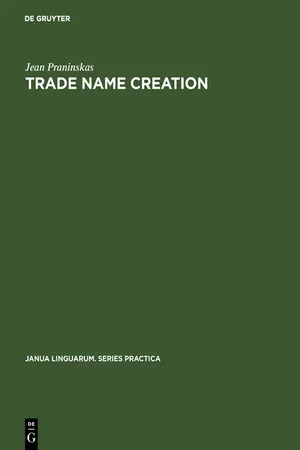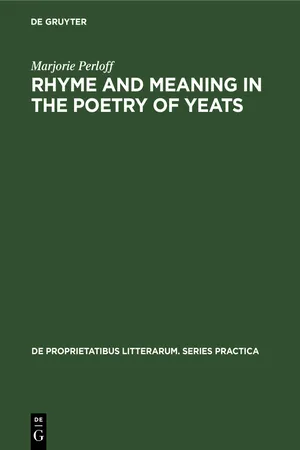Languages & Linguistics
Eye Rhyme
Eye rhyme is a type of rhyme in which two words are spelled similarly but pronounced differently. This type of rhyme is based on the visual appearance of the words rather than their sound. Examples of eye rhyme include "love" and "move" or "laughter" and "daughter."
Written by Perlego with AI-assistance
Related key terms
1 of 5
3 Key excerpts on "Eye Rhyme"
- eBook - PDF
Studies in the History of the English Language
A Millennial Perspective
- Donka Minkova, Robert Stockwell, Donka Minkova, Robert Stockwell(Authors)
- 2008(Publication Date)
- De Gruyter Mouton(Publisher)
Such a context is certainly provided in, say, the rhyme in (4a), in which both the stress on the final syllable that the meter causes to be expected, and also the quality of the vowel that the rhyme causes to be expected, never come to be quite fully embodied in the language, but hover ghostlike, pre-cisely like the memory they denote. Finally, wouldn’t the use of variants in general be at odds with the construction of a lyric voice? Whatever freedom a single speaker might have had in choosing a pronunciation for a given word, it seems likely that as with spelling variants in the period, there would have been consistent characteristic practices, such that variation be-tween forms would have compromised the coherent sense of a single speaking subject. And what exactly is an Eye Rhyme? The idea is summarized by Kökeritz (1953: 31) as follows: … already in the 16th century, and probably earlier, there had apparently developed a rhyming tradition that was to some extent independent of the contemporary pronun-ciation. Each new generation of poets preferred to use more or less the same rhymes as the preceding one and continued to do so long after some of the syllables they coupled in rhyme had ceased to be pronounced alike; in such cases the conventional spelling preserved an illusory, purely graphic or visual identity which had no counter-part in the pronunciation of the rhyming syllables. This is the genesis of the Eye Rhyme ... 220 Kristin Hanson Thus, an Eye Rhyme is just a traditional rhyme in which the past identity on which the rhyme is based is preserved in the spelling. The spelling, how-ever, seems to in fact be of very little consequence; it is certainly not a cre-ative principle of rhyme in its own right in the Sonnets. - eBook - PDF
Trade name creation
Processes and patterns
- Jean Praninskas(Author)
- 2017(Publication Date)
- De Gruyter Mouton(Publisher)
90 AESTHETICS 5.12 Rhyme, on the other hand, is an entirely different matter, though its function is similar: to incite emotional attitudes in the reader. 4 Indeed it is treated by some authors as merely an element of rhythm. s So long as a name consists of more than one syllable it has rhyme potential. In our corpus we find a number of trade names exhibiting the various types of rhyme used in English verse. We note first those with end-rhyme, in which a stressed vowel and all of its following consonants, if any, are repeated. This is found in such names as BOOK NOOK, FLIGHT LIGHT, FRI DRI, GET SET, HIP NIP, LILT KILT, SLUG-A-BUG, SNO GLO a n d SNO THRO, SPEED FEED, SPRING DING, TILE SMILE, TWEEDS AND WEEDS, ZIP-GRIP a n d ZIP-STRIP. Historically much older — indigenous, in fact, to all Germanic languages with their preponderance of initial stress, is head rhyme or alliteration, the repetition of initial consonants in stressed words or syllables. It is not surprising, therefore, that we find more than twice as many instances of this type of rhyme in the corpus, among them CLEAR COAT, CHROMCRAFT, COCA COLA, CONSTANT COMMENT, CUTICURA, DRI-DON, FILTER-FLO, FLIP-A-FLAP, GARDEN-GARD a n d GARD-N-GRO, KEY KADDY, KIDDIE KEEPER, KIT ΚΑΤ, KOFFEEKIT, KOLD KUP, KOPY ΚΑΤ, LIMELIM, MIX 'N MATCH, PERSIAN PRINCESS, PIC-A-PUFF, PICK-A-PACK, PICK-A-POWER, PLANT PENS, PLATTER PAK, PLEATS 'N PEARLS, SANI-SCANTS, SPEED SNIPS, SPIN 'N SWING, TALENT TABLET, TERRACE TOTER, TOUCH 'N TELL, TOUCH'N TONE, WELDWOOD, WISPERWATE, WIND-O-WONDER, WISHY WASH. Slant or near rhyme is noted in the many cases of assonance, such as CADMAX and SNO-BOL , and consonance, such as FLIP-A-FLAP and WELDWOOD . - eBook - PDF
- Marjorie Perloff(Author)
- 2019(Publication Date)
- De Gruyter Mouton(Publisher)
20 Webster's Third New International Dictionary. 21 All linguistic terminology used in this book is based on that of George L. Trager and Henry Lee Smith, An Outline of English Structure, Studies in Linguistics, Occa-sional Papers No. 3 (Norman, Oklahoma, 1951). For a more recent version of Trager and Smith one may consult H. A. Gleason, An Introduction to Descriptive Linguistics, rev. ed. (New York, 1961). Gleason uses Trager and Smith's terminology throughout. Another good recent treatment is that of John P. Hughes, The Science of Language (New York, 1962). 30 THE PHONETIC FUNCTION OF RHYME IN YEATS'S POETRY as in black/ tack, the rhyme is called exact rhyme; when the corre-spondence is incomplete, as in bleak/tack, or when the two rhyming units have different degrees of stress, as in me/ memory, the rhyme is called APPROXIMATE RHYME. Approximate rhymes fall into three broad categories. The first category involves two rhyming units that have primary stress and PHONEMIC VARIATION , that is, imperfect v-c correspondence. Yeats uses the following types of approximate rhyme involving phonemic variation: 1. CONSONANCE-RHYME occurs when the final consonant sounds of the stressed rhyming units agree but the vowel sounds differ. 22 For example, Yeats uses consonance-rhyme in In Memory of Major Robert Gregory (151): That cast their shadows upon road and bridge The tower set on the stream's edge .... (lines 51/52) 2. EYE-RHYME occurs when the rhyming units are spelled alike but are pronounced differently; phonetically, eye-rhyme is generally equiva-lent to consonance-rhyme. For example, Yeats uses eye-rhyme in Easter 1916 (200): The long-legged moor-hens dive, And hens to moor-cocks call; Minute by minute they live .... (lines 53/55) 3. CONTRAST-RHYME occurs when there is assonance of the vowels in the stressed rhyming units, but the final consonants have a voiced/ voiceless contrast.
Index pages curate the most relevant extracts from our library of academic textbooks. They’ve been created using an in-house natural language model (NLM), each adding context and meaning to key research topics.


